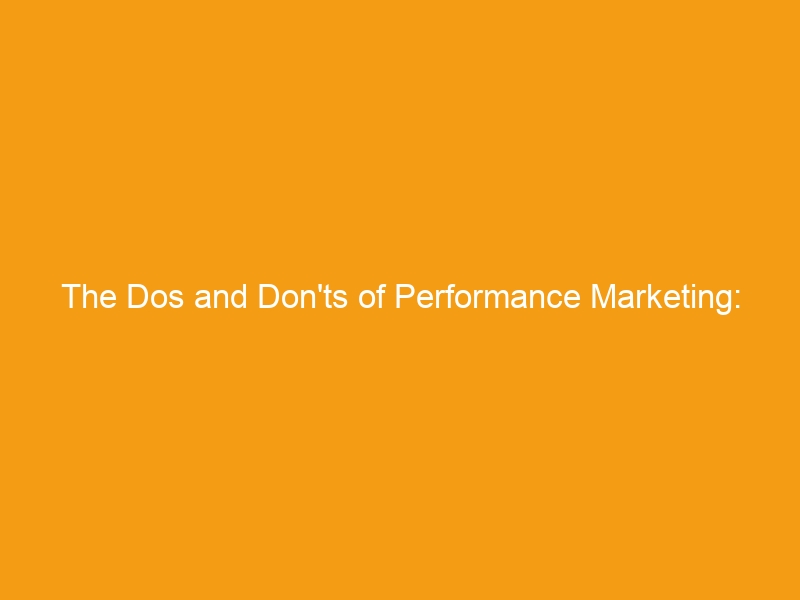There’s no way around it: B2B performance marketing is a significant challenge.
At first glance, running a performance-based campaign doesn’t seem too difficult. It’s performance-based, so you only pay for the clicks or conversions you get. And if you target the right keywords, you should be good to go, right?
Unfortunately, there’s more to it than that. Many B2B businesses make costly mistakes when running performance campaigns, and they end up paying more than they should for getting poor results.
In this article, we’ll go over some of the most critical mistakes companies make when it comes to performance marketing and how to avoid them.
1. Forgetting about on-page optimization
Most people think about web traffic when they think about marketing campaigns. They equate more traffic to more sales revenue.
As long as more targeted traffic lands on a website, more sales should come as a direct result.
The reality: web traffic is costing you money, not printing it for you.
To get the most out of your campaigns, you need to make sure that when visitors land on your website, they have an excellent experience. That means ensuring that the webpages are optimized for maximum conversions.
This includes optimizing page load speed, making sure all pages are mobile-friendly, and having clear calls-to-action (CTAs) that lead visitors to the right places. Beyond the basics, it also requires some knowledge of UX design and A/B testing to maximize the effectiveness of a website.
As for your copy, writing it with ChatGPT might save you time, but it probably won’t connect with your potential customers. To sell the way you want to, your copy has to be compelling, persuasive, and tailored to your audience.
2. Having the wrong data
Data from the CMO Council found that nearly half of the marketers are only “moderately” confident in their data.
There are several reasons for this:
- Data from customer interactions, website visits, ad campaigns, and email campaigns are often siloed, meaning that marketers can’t get a comprehensive view of their customers.
- Many companies lack the proper tools for extracting and analyzing data efficiently.
- Those with the right data and the right tools can still misinterpret it or misuse it.
- TV viewership trends, search engine algorithms, and social media platforms are constantly changing, making advertising an unclear science.
To be successful in B2B performance marketing, you need to invest in the tools and resources needed for collecting and analyzing customer data.
3. Overlooking attribution models
Even if you have all the data you need, it won’t do you much good if you don’t understand how to use it. Attribution models help you understand customer behavior and the customer journey.
Examples include:
- Single-touch attribution, which tracks one touchpoint (e.g., a banner ad)
- Multi-touch attribution, which follows multiple touchpoints (e.g., email and website visits)
- Time decay attribution, which assigns more weight to recent touchpoints
- Position-based attribution focuses on the first and last touchpoints.
Attribution models help you understand how customers interact with your site, what works and what doesn’t work, and where potential customers drop off in the conversion funnel.
Using attribution models, you’ll be able to fine-tune your campaigns, target the right customers at the right time, and optimize for maximum return on investment.
4. Targeting expensive keywords
With performance-based models, the cost per click or impression is much higher for popular (i.e., generalized) keywords and phrases.
The key is to not focus on the most expensive keywords but rather to find the ones that are cost-effective for your campaigns.
Using search volume tools like Google Keyword Planner and reviewing competitor insights can help you assess which keywords may be more appropriate for your budget range.
For example, keywords like “CRM” have cost-per-click rates of up to $50. Assuming an average conversion rate of 5%, that means your cost per conversion could be as high as $1,000.
Most of the traffic that will actually convert will come from smaller demographics, targeted keywords, and long-tail phrases.
Although it requires more research and testing, this is a much more cost-effective option for performance marketers looking to maximize ROI.
5. Not having an effective retargeting strategy in place.
Retargeting is a powerful tool, but it’s one of those tools that can easily be misused if you don’t know what you’re doing. The idea behind retargeting is to show ads to people who have already interacted with your brand in some way.
Many businesses try to retarget too broadly, sending out generic ads to everyone who visits their website. Not only can this be expensive, but it will probably annoy potential customers.
Instead, focus on creating more targeted campaigns that address the specific needs of a particular audience segment or feature products and services tailored to their interests.
It’s also important to keep retargeting ads fresh and relevant by regularly reviewing campaign performance and switching up ad copy, images, and calls to action.
Final Thoughts
Performance marketing is a complex and ever-evolving field, but these five tips should help you get started on the right track.
By investing in the right tools and resources to collect customer data, understanding attribution models, targeting cost-effective keywords, and having an effective retargeting strategy in place, you can ensure that your performance marketing efforts are optimized for maximum return on investment.

